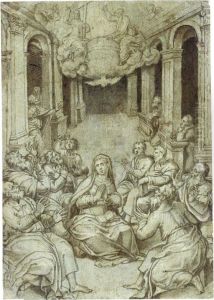Mechtelt Toe Boecop Paintings
Mechtelt toe Boecop was a Dutch Renaissance painter, born around 1558 in Kampen, a city located in the province of Overijssel, Netherlands. Little is known about her early life or artistic training, but she is one of the few female artists from this period whose work and identity have been preserved in historical records. Mechtelt was married to Hendrick toe Boecop, a lawyer and later burgomaster (mayor) of Kampen, and her social status likely provided her with the means and time to pursue her interest in painting.
Mechtelt toe Boecop's known oeuvre is quite limited, and her work was primarily focused on portraiture. Her most famous painting is a self-portrait that was completed in 1600. This work is significant for its detailed depiction of the artist and for the fact that self-portraits by women from this period are exceedingly rare. The self-portrait features Mechtelt in a black dress with a white collar, holding a pair of gloves, a common symbol of social status during that era. The painting is also notable for its inclusion of a window in the background, which opens to a view of a distant landscape, adding depth and context to the portrait.
Mechtelt's style is characteristic of the Northern Renaissance, with an emphasis on realism and attention to detail, particularly in the rendering of fabrics and textures. While her body of work may have been larger, it is likely that many of her paintings have been lost or remain unidentified as works by a female artist from the 16th century. The historical record of Mechtelt toe Boecop's life is sparse, and as with many women of the time, her contributions to the arts were likely overshadowed by her male contemporaries.
Mechtelt toe Boecop passed away in 1604. Despite the limited number of her works that have survived, she remains a figure of interest in the study of female artists of the Renaissance and their often overlooked contributions to the art historical canon. Her surviving self-portrait not only provides insight into her own image and status but also serves as a rare example of female artistic agency during a time when women's roles in society were highly restricted.
